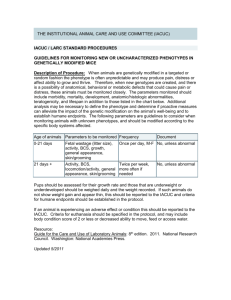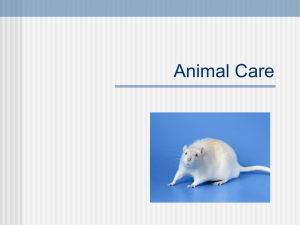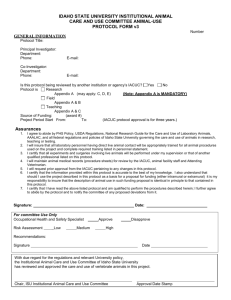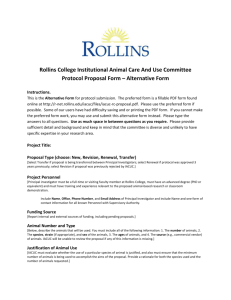Animal Study Protocol Application Form
advertisement
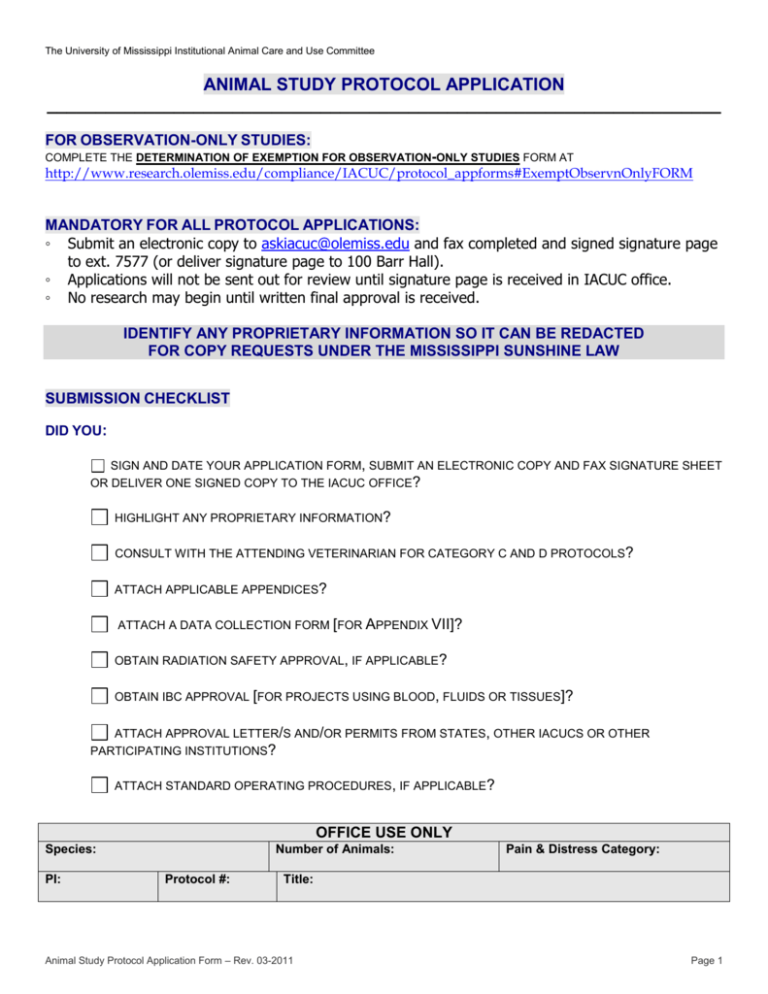
The University of Mississippi Institutional Animal Care and Use Committee ANIMAL STUDY PROTOCOL APPLICATION _____________________________________________________________________ FOR OBSERVATION-ONLY STUDIES: COMPLETE THE DETERMINATION OF EXEMPTION FOR OBSERVATION-ONLY STUDIES FORM AT http://www.research.olemiss.edu/compliance/IACUC/protocol_appforms#ExemptObservnOnlyFORM MANDATORY FOR ALL PROTOCOL APPLICATIONS: ◦ Submit an electronic copy to askiacuc@olemiss.edu and fax completed and signed signature page to ext. 7577 (or deliver signature page to 100 Barr Hall). ◦ Applications will not be sent out for review until signature page is received in IACUC office. ◦ No research may begin until written final approval is received. IDENTIFY ANY PROPRIETARY INFORMATION SO IT CAN BE REDACTED FOR COPY REQUESTS UNDER THE MISSISSIPPI SUNSHINE LAW SUBMISSION CHECKLIST DID YOU: SIGN AND DATE YOUR APPLICATION FORM, SUBMIT AN ELECTRONIC COPY AND FAX SIGNATURE SHEET OR DELIVER ONE SIGNED COPY TO THE IACUC OFFICE? HIGHLIGHT ANY PROPRIETARY INFORMATION? CONSULT WITH THE ATTENDING VETERINARIAN FOR CATEGORY C AND D PROTOCOLS? ATTACH APPLICABLE APPENDICES? ATTACH A DATA COLLECTION FORM [FOR APPENDIX VII]? OBTAIN RADIATION SAFETY APPROVAL, IF APPLICABLE? OBTAIN IBC APPROVAL [FOR PROJECTS USING BLOOD, FLUIDS OR TISSUES]? ATTACH APPROVAL LETTER/S AND/OR PERMITS FROM STATES, OTHER IACUCS OR OTHER PARTICIPATING INSTITUTIONS? ATTACH STANDARD OPERATING PROCEDURES, IF APPLICABLE? OFFICE USE ONLY Species: PI: Number of Animals: Protocol #: Pain & Distress Category: Title: Animal Study Protocol Application Form – Rev. 03-2011 Page 1 The University of Mississippi Institutional Animal Care and Use Committee ANIMAL STUDY PROTOCOL APPLICATION A. Administrative Data [text boxes will expand] 1. Project Title: 2. Principal Investigator [only faculty, post-doctoral student, or staff may submit an application]: Name: Department: Telephone: Email: 3. Animal Protocol Director [person directing animal study if other than PI]: Name: Department: 4. Student Project: Dissertation Student name: Telephone: Thesis Telephone: N/A Email: Grant/Contract No: PI on Grant/Contract: Project Period: Research 7. Protocol Category: Other: N/A Funding Agency/Organization: 6. Protocol Type: Email: Undergraduate [including Honors College] Department: 5. Funding Information: N/A Breeding New Teaching / / to / / Other: Continuation of Protocol #: 8. Suggested Pain and Distress Category: 9. Personnel Working with Animals on this Project: Role Involving Animal Use [Be specific. An “X,” “All” or “Yes” is not an acceptable description of personnel responsibilities.] Name Department Phone Email Monitor animals [Feeding, breeding, etc.] PI Conduct Experimental Procedures [Surgery*, blood draws, etc.] Describe specific training & expertise [Identify trainer and include brief outline of expertise/ qualifications of person to train others.] IACUC Approved [Check ‘yes’ ONLY if they have completed all required training and are approved to work with animals] Yes Yes Yes Yes No No No No *Surgery requires 1) training and 2) technique performance approval by Dr. Fyke. Submit ‘Proficiency Criteria for Research Animal Surgery’ form to Dr. Fyke, B104 NCNPR. 10. Personnel Responsible for Animal Care: Name Phone Dr. Harry Fyke 915-5324 Email Animal Care [Required: check personnel responsible for each] Daily Weekend Holiday Emergency hfyke@olemiss.edu 11. Location/s where Animals Will Be Housed or Procedures will be Performed [check with Animal Facility Supervisor about available space and indicate whether animals will be housed for more than 12 continuous hours for each area]: Building(s)/Room(s) Number: >12 hours Yes No Building(s)/Room(s) Number: >12 hours Yes Building(s)/Room(s) Number: >12 hours Yes No Other Participating Institution: Animal Study Protocol Application Form – Rev. 03-2011 No Page 2 The University of Mississippi Institutional Animal Care and Use Committee B. Overview and Rationale of Study It is generally not the responsibility or intent of the IACUC to review protocols for scientific merit. The following information is required to assist the committee in evaluating the relevance of the animal model and procedures to be used. 1. Briefly describe the general experimental design and procedures [This should be no more than ONE PAGE and written at HIGH SCHOOL LEVEL or for non-scientists. DO NOT USE JARGON and DEFINE ABBREVIATIONS and ACRONYMS. The details of specific animal procedures, such as injection sites, surgery, and anesthetics are not required here.]: 2. Briefly state the rationale/purpose and significance of the project [This should be no more than ONE PAGE and written at HIGH SCHOOL LEVEL and for non-scientists. DO NOT USE JARGON and DEFINE ABBREVIATIONS and ACRONYMS.]: 3. Duplication of Research [enter information in table below]: Database Publication Years Key Words Date of Search Used Covered From To Search Results No duplication Duplication is necessary because: 4. Animal Model/s: *No. of Genus/Species Animals for 3 yr period Strain, Stock or Breed Age and/or Size Sex Daily Census** Average High * If breeding protocol, put number you are requesting to maintain at any given time. **During the times animals will be housed, list the average and estimated high # of animals to be housed on any given day 5. Provide rationale for choice of animal model/s: 6. Justify Animal Numbers: Justification for animal numbers should be thoroughly supported by current resources. Information collected from (your and/or previous) research, during conferences, from journal articles, and through database searches can help provide statistical justifications and sound rationale for the number of animals used: 7. Name of animal supplier/location: 8. Animal Type [REQUIRED: Animals will be quarantined upon arrival. Submit animal health status report.]: In-house transfer [approved form on file] Wild caught – [complete Appendix III] Bred in-house Captive bred 9. Is anything other than routine care and equipment required? Solid bottom cages Laminar flow room Autoclave feed, bedding and cages Purpose bred From other institution/s [provide name]: Yes – complete checklist Unique light Individual housing Filter tops No Special diet Treated water Wire bottom cages: Justify: Clarify if necessary and/or list other requirements: Animal Study Protocol Application Form – Rev. 03-2011 Page 3 The University of Mississippi Institutional Animal Care and Use Committee 10. Describe the cleaning procedures and schedule for animal enclosures not in the vivarium, including person responsible for their maintenance. Provide justification if cleaning intervals exceed 2 weeks. N/A: Vivarium Housing 11. Will animals be physically restrained longer than one hour in a conscious state? Yes – complete table & justify No – proceed to #13 Species Purpose Type of Restraint Frequency Duration Justify duration of restraint: 12. How will animals be monitored while they are restrained? [Attach form for monitoring physically restrained animals]: 13. Have any of these animals been previously used in an experimental procedure or another protocol? Yes – list species and explanation below No Species Explanation 14. Will you be administering a substance? Yes – complete table below Species Substance Dose Route of Frequency Administered Administration No Volume Agents unknown/not previously tested in vivo 15. Is it likely animals in this protocol will experience pain or distress? No – proceed to #17 Yes – explain and list methods to minimize pain and distress: 16. Justify unrelieved severe or chronic pain and distress: 17. REQUIRED: Conduct literature search for alternatives [ways to reduce numbers of animals used, replace animal model, or methods to refine the study to lessen or eliminate pain or distress]: ◦ Date search conducted: ◦ Publication years covered: to ◦ Keywords/search strategy used [List keywords used to conduct your search using terminology from your responses to the above, e.g., alternative, in vitro, in vivo, ex-vivo, assay, technique, cell culture, cultured cells, tissue culture, simulation, animal testing alternative, non-animal model, etc.]: 18. Databases searched/sources consulted for alternatives: This site must be included in the search: ALTWEB [http://altweb.jhsph.edu] Also choose from one or more of the following: ASFA AWIC AGRICOLA BIOSIS Google Scholar Life Sciences SciSearch / Web of Science CAB MEDLINE (PubMed) Current Contents NTIS Pascal EMBASE FEDRIP PsycINFO TOXLINE Other specialized databases and web resources (specify): 19. List any potential alternatives of which you are aware [e.g., alternate models, modified techniques, housing modifications, modified restraint, in vitro methods, computer simulations, etc.]: 20. Did you find any ways to reduce animal numbers? Animal Study Protocol Application Form – Rev. 03-2011 Page 4 The University of Mississippi Institutional Animal Care and Use Committee 21. Did you find any methods that minimize pain or distress? 22. Can you replace your animal model with a non-animal model or less sentient species? Why or why not? 23. Will you be using non-pharmaceutical grade drugs? No Yes – List each drug, its intended use and provide justification [contact Attending Veterinarian (x5324) for ordering information]: 24. Biological Fluids Collection: A. Will biological fluids be collected? [e.g., blood, lymph, bile, cerebrospinal fluid, urine, etc.] Yes – complete table below No – proceed to #25 Species Fluid Volume Collection frequency Collection site Anesthetic B. If fluids are collected, will animals survive the fluid collection procedure? Yes Dose No N/A 25. Disposition of Animals (REMINDER: Multiple surgeries require justification.): Will animals be euthanized? Yes – Describe method by species to be used, including dose and route (if applicable): No: Transferred to breeding protocol # _________ Transferred to another research protocol # _________ Other: 26. Disposal of animals that die while on study: Freeze Refrigerate Do not save Other: 27. Humane Endpoints - Ideally, humane endpoints (predictive signs, indicators of an irreversible deteriorating condition) should be established prior to beginning animal work. Realizing the difficulty in predicting these for studies which involve compounds with unknown adverse effects, PIs should try to develop humane endpoints if severe pain, severe distress, or death is observed. Guidelines should be in place to euthanize animals when humane endpoints are reached, when the study objectives have been realized, if it becomes clear that they cannot be realized, or whenever the degree of suffering is not required or justified by the protocol. A. Explain how animals with severe responses will be handled. B. List signs of pain and distress severe enough to indicate the need for euthanization. C. State the method of euthanasia if different from 25 above. 28. Is death, not resulting from euthanasia of any animal subject, an endpoint in any of the studies in your project? No Yes – provide scientific justification: 29. CHECKLIST: A. Experimental Disease Induction: Will animals be inoculated for experimental purposes? No Yes – complete Appendix I B. Tumor Induction: Will animals be inoculated with tumor cells? No Yes – complete Appendix II C. Wild Caught Animals: Will wild caught animals be obtained for this study? No Yes – complete Appendix III D. Radioisotopes, Toxic Chemicals, or Biological Hazards: Will personnel be exposed to radioisotopes, carcinogens, or infectious agents? No Yes – complete Appendix IV E. Surgical Procedures: Will survival or non-survival surgical procedures be performed? No Yes – complete Appendix V F. Novel Compounds: Will any new or unknown drugs, compounds, or biological extracts be used in this protocol? No Yes – complete Appendix VII Animal Study Protocol Application Form – Rev. 03-2011 Page 5 The University of Mississippi Institutional Animal Care and Use Committee C. Investigator Assurance or N/A This application does not diverge from methods/procedures in the full grant application (if project is funded). The information provided in this protocol form accurately reflects the intended use of animals for this research or teaching activity. or N/A I have consulted with the Attending Veterinarian regarding any experiments that are classified in pain and distress categories C or D. Any changes in procedures will not be undertaken without prior notification and approval of the Institutional Animal Care and Use Committee. The activities described in this study do not unnecessarily duplicate previous experiments. Prior to participation in the protocol, all persons listed/involved in the use of animals on this protocol: ◦ ◦ ◦ Have been informed of the experimental objectives and methods. Have received/will receive training in the execution of animal-related procedures he/she will perform and will participate in any educational or training programs deemed appropriate or necessary by the IACUC, including the mandatory training for research animal surgery. Have met/will meet the requirements of The University of Mississippi Occupational Health Program. I agree to use appropriate anesthesia and/or analgesia to relieve pain/distress whenever use of these agents will not jeopardize the scientific validity of the data. I have read the Guidance on Humane Endpoints and agree to follow it to minimize pain, distress or illness in laboratory animals. I will take appropriate steps to avoid exposure of project personnel to hazardous agents in the study. If the IACUC approves my application, I agree: ◦ ◦ ◦ To execute this work as described. To comply with the guidelines set forth by the IACUC and The University of Mississippi’s Department of Health and Safety. To be responsible for the supervision and work of my staff. I agree to comply with the requirements of the following: ◦ ◦ ◦ Public Health Service Policy on Humane Care and Use of Laboratory Animals. Provisions of the USDA Animal Welfare Act and Regulations. UM’s policies governing the use of animals in research, testing, or teaching. State the reason/s if you cannot agree to any of these statements: Animal Study Protocol Application Form – Rev. 03-2011 Page 6 The University of Mississippi Institutional Animal Care and Use Committee SIGNATURES Department _______________________________________________ Principal Investigator / Project Director ______________________________________ Date _______________________________________________ Department Chair ______________________________________ Date IACUC Approval _______________________________________________ IACUC Chair ______________________________________ Date _______________________________________________ Attending Veterinarian ______________________________________ Date Animal Study Protocol Application Form – Rev. 03-2011 Page 7
